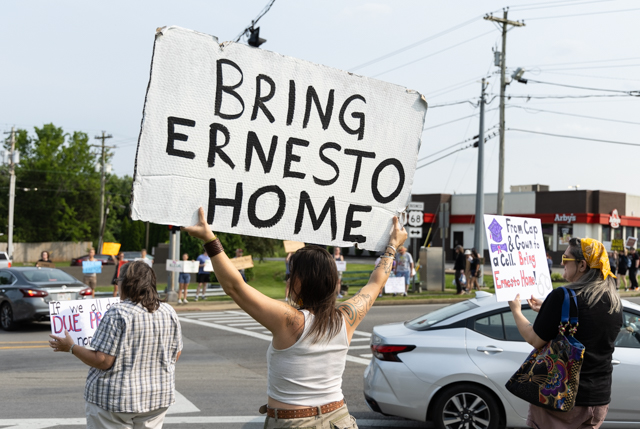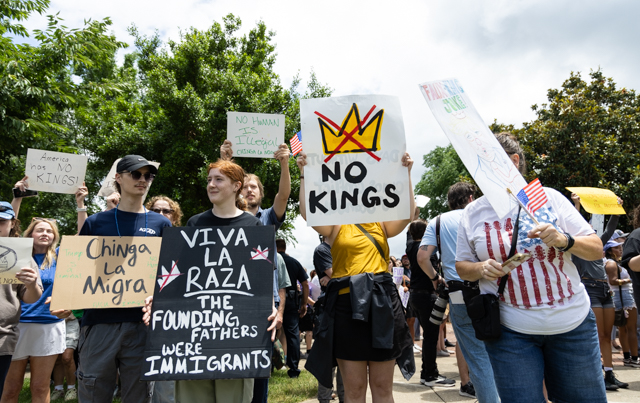Spotlight on diversity
Published 12:00 am Wednesday, September 26, 2001
Lawrence Snyder, an associate professor of Religious Studies at Western Kentucky University, talks about a religious diversity project Bible Belt Religions: Mapping Religious Diversity Along the Corridor. Photo by Joe Imel
The tapestry of religious faiths that decorates Bowling Greens cultural landscape has caught the attention of a nationwide magazine and Harvard University. The growing diverse population of Bowling Green will be featured in an article in the October edition of Kipplingers magazine. Western Kentucky University philosophy and religion Associate Professor Larry Snyder and former Western religion Professor Tom Russell received a grant from Harvard in the summer of 2000 to work on the Pluralism Project, a study to document the growing religious diversity in the United States. The Public Broadcasting System contacted Harvard about developing a documentary about diversity in the south and Harvard recommended it contact Western, according to Snyder. The Western project is concentrating on mapping religious diversity along the I-65 corridor from Nashville to Louisville. The PBS documentary will concentrate on Nashvilles diversity. When I moved to Bowling Green in 1990, this was the most homogeneous region of the country I had ever lived in, Snyder said. I couldnt believe it. I had people come to my class and say they had never even met a Catholic. I found that astounding and of course, thats changed dramatically in the last decade. One example of the drastic change in the community was the interfaith prayer service held at Fountain Square Park after the Sept. 11 terroristic crash of planes into the World Trade Centers and the Pentagon, Snyder said. For the first time in Bowling Greens history, the Koran was read on the public square, he said. We had the Jewish community, the Christian community, the Muslim community, the Imam Muaz Redzic read from the Koran, we sang and prayed together. It was very meaningful. Although there were no Buddhist, Jains, Sikhs or Hindus present, Snyder opened the meeting by announcing they are part of our community too … were praying with them and for them as our fellow citizens and neighbors. The Pluralism Project will last three years with three main objectives: identify the diverse religious communities and recent cultural changes; study how these religious communities have adapted to their new contexts; and interpret religious change in contemporary American society, examining the role these new communities play. Lots of folks like to talk about America as a Christian country, Snyder said. America is the most religiously diverse nation in the world. If we were ever a Christian country whatever that means were not any longer, at least not exclusively. The first phase of the Pluralism Project will concentrate on Nashville and Bowling Green, the second part will look at Bowling Green to Louisville and the third phase will center around a public conference to discuss the findings, Snyder said. Western students are helping the professors collect the data. Reasons for diversityLow unemployment, low cost of living and good opportunity for housing made Bowling Green a prime target for resettlement agencies, causing diversity to boom in Bowling Green, Snyder said. The Chamber of Commerce has been actively recruiting to bring in industries and encourage them to expand, he said. Of course, Eagle Industries is expanding and they bring in Hispanic workers. The Western Kentucky Refugee Mutual Assistance Association, now simply called the International Center, has brought more than 3,000 immigrants to Bowling Green since it opened its doors 19 years ago, according to its founder Martha Deputy. Although the center has not brought in vast numbers, it sends a message this area has resources to help immigrants and has made Bowling Green attractive, Snyder said. The religious impact of the immigrants on the community is more important than how many numbers there are of each particular group. We are trying to get a round, ball-park figure of the numbers, he said. We are more interested in identifying where they are worshiping. Refugees fleeing to Bowling Green to escape the war in Bosnia has made Islam the second-largest religious group in the city, after Christianity, Snyder said, adding he recently revised the numbers of Bosnians to between 2,500 to 3,000.Easily 75 percent are Muslim by background, he said. If you add to that anywhere from 500 to 700 people from Southeast Asia … you have an Islamic population (potentially) hovering somewhere between 5 to 7 percent of the population. The Asian population accounts for 1.4 percent of Warren County, which is double the percentage for the state, Snyder said. Bowling Green is also home to 12 Buddhist families from Southeast Asia. Information is still being collected on the Hindus and should be released in six months. The majority of Hindus have home shrines, Snyder said. Those who worship publicly typically go to Nashville. The Hispanic population is now at 2.7 percent for Warren County, according to the Census Bureau. That is still 1.5 percent higher than the rest of the state, he said. The majority of those are Catholic, but not all. La Luz Del Mundo the Light of the World is a Spanish Apostolic Protestant church, based in Guadalajara, Mexico, which has located in Bowling Green. This is what you might call a missionary church, he said. They have about a 100 members and most of them came up through Eagle Industries. One of the main objectives of the Pluralism Project is to find out if the minority faiths have been welcomed in the Bible Belt, Snyder said. Nabil Loutfi, a Western graduate student from Casablanca, Morocco, is Muslim and has lived in Bowling Green for two years. There are a lot of refugees here from Bosnia, so there was a Muslim community here, he said. People are very tolerant. Ive never had any problems. Ive got a lot of American friends. The Jainism family in Bowling Green were more than willing to share their faith until Sept. 11s attacks. Although Jainism has nothing to do with Islam, they did not want to be identified because of fear of reprisals. Jainism originated more than 2,000 years ago in India. Its followers believe in non-violence, karma and reincarnation. They follow fruititarianism, which is the practice of only eating that which will not kill the plant or animal from which it is taken. Only one Sikh family resides in Bowling Green, according to Indudeep Chhachhi, the accounting and finance co-chair at Western. Ive been treated very well, he said, in reference to his Sikh faith. Ive been here 17 years overall in the U.S. … I have not had any trouble. It is somewhat less of a problem for me because I do not wear a turban. There are two types of Sikhs, those who wear turbans and those who do not, Chhachhi said. Four days after the Sept. 11 attacks, a turban-wearing Sikh was shot and killed in Mesa, Ariz., by a gunman who claimed to be doing his patriotic duty. Because of his exposure to cultural diversity while growing up in India, adjusting to the Bible Belt has not been a problem for Chhachhi. We in India are use to religious diversity, he said. There are so many beliefs and languages in India that for us, coming across somebody who looks totally different or has different religious beliefs or speaks a totally different language is norm. Sikhism was founded hundreds of years ago and teaches the equality of beings. Worship and prayer is done individually and as a group by sitting on the around their holy book, Guru Granth Sahib, written by 10 gurus, according to Chhachhi. We do our individual prayers from time to time, Chhachhi said. As a group, we do prayers only on specific occasions. We worship a holy book; our holy book includes verses and teachings of both Hindus and Muslims. We worship the way of life, lead a good life, treat everybody equally and do the right thing. Diversity educationChhachhis beliefs teach him to value the experiences when he or his family are exposed to other religions. Our religion teaches there is no differences between people, irrespective of what religion they belong to, he said. From my standpoint if somebody is teaching my child about Judaism or Christianity, Im perfectly happy. Ive had people come knock on my door and talk about Jesus and the Bible and I listen to them and thats perfectly fine … I look at this as a learning opportunity. Education is another driving force behind the Pluralism Project, according to Snyder. Our role on this project ultimately is to educate our area of the commonwealth about the variety of religious traditions that are already here, he said. These people are every bit as much American as your God-fearing Christian and they are part of the fabric of the American life as well. Snyder and Russell have now applied for a grant, which is pending approval, from the Louisville Institute at the Louisville Presbyterian Seminary, which concentrates more on the diversity of immigrant Christian communities. Up to this point, the project has not concentrated on Christians in the area.






